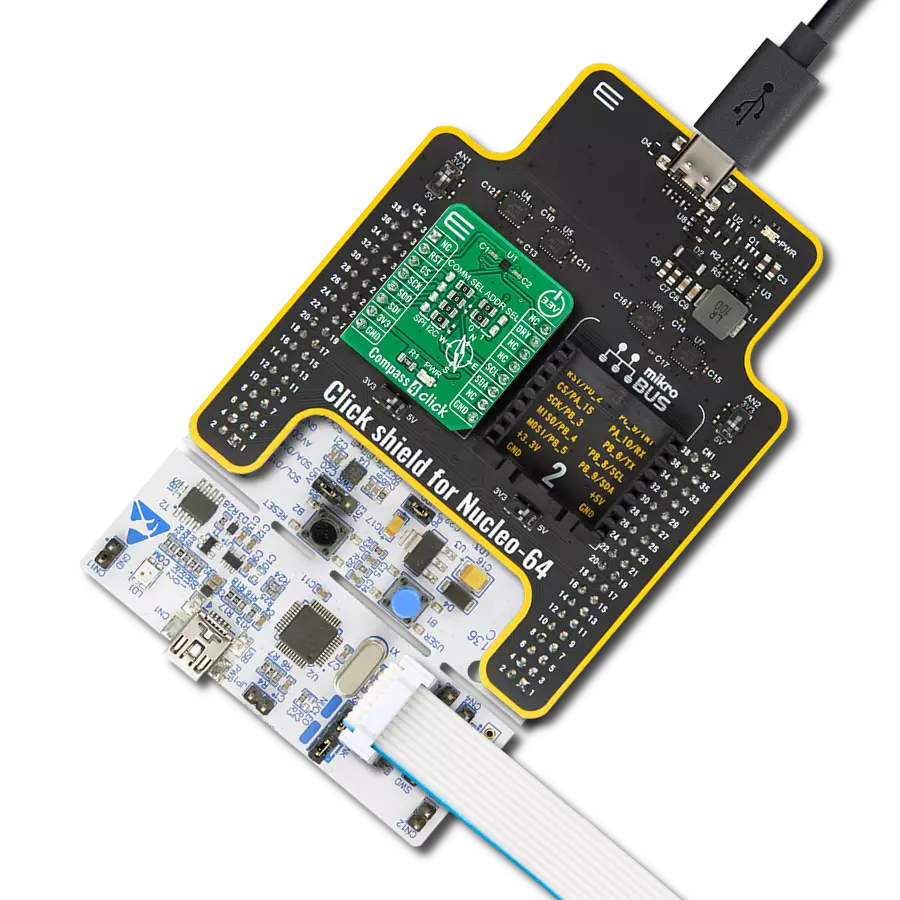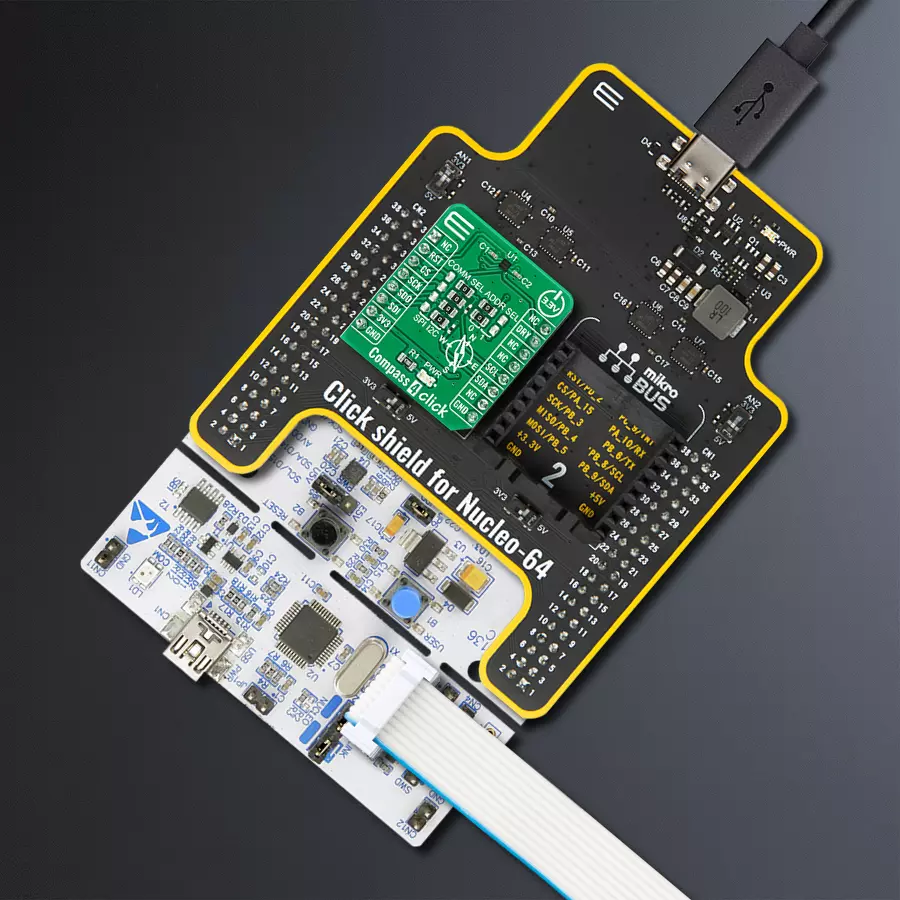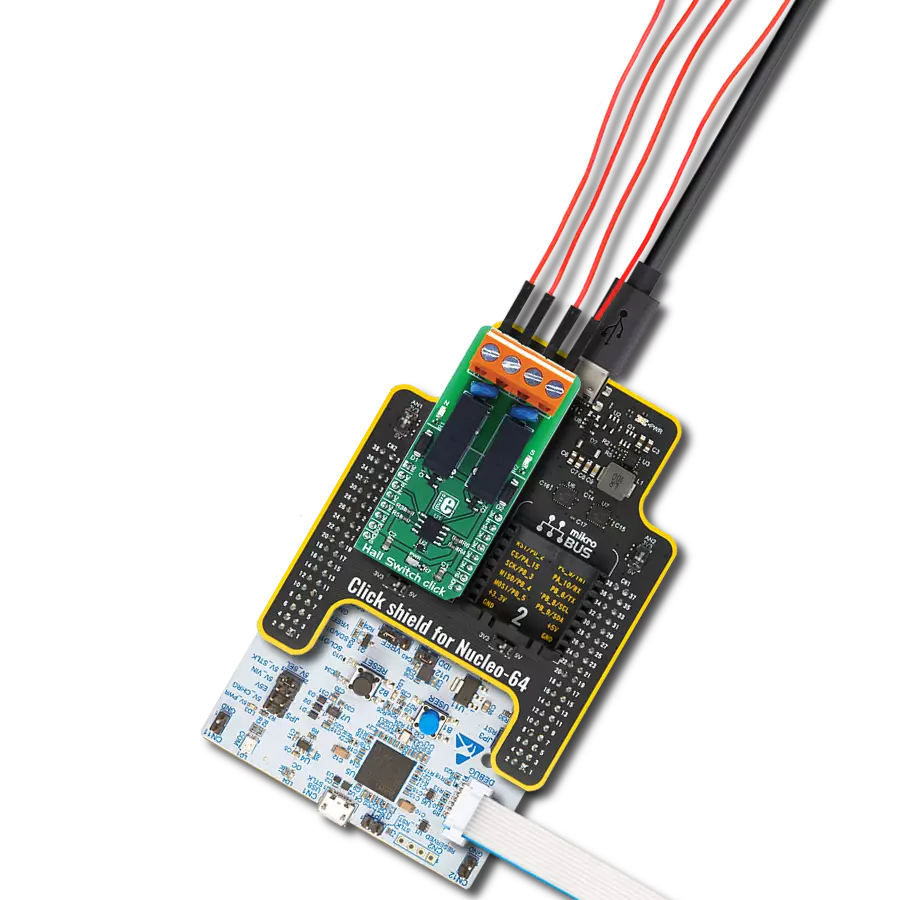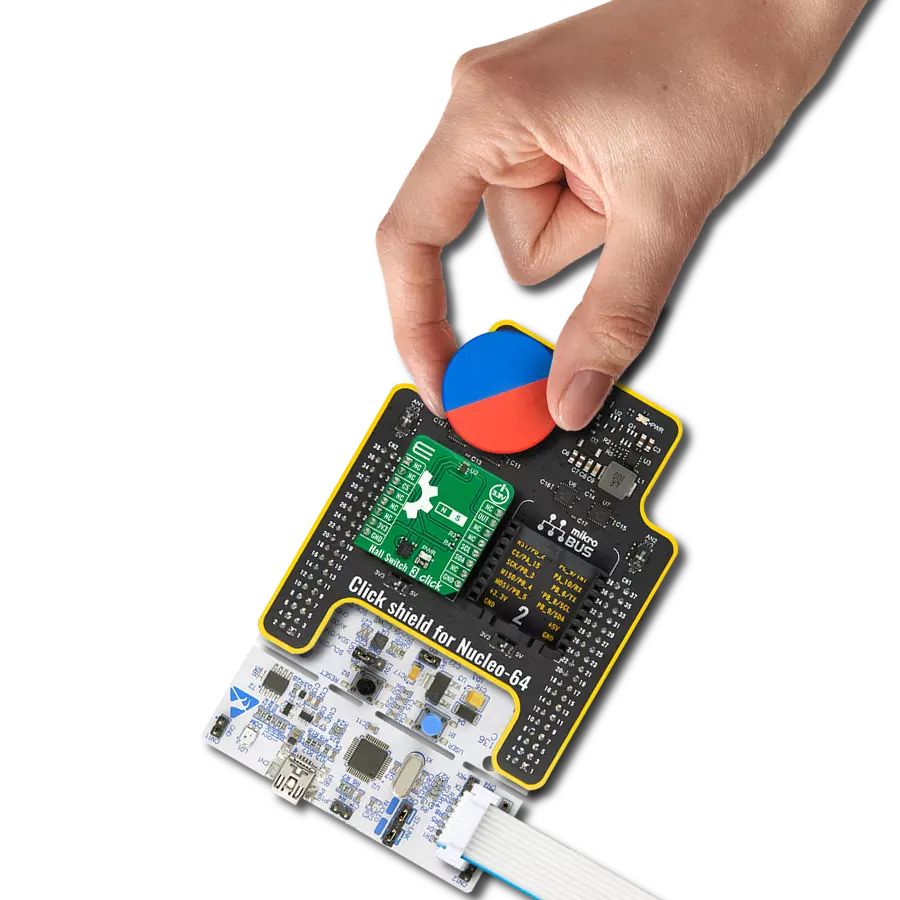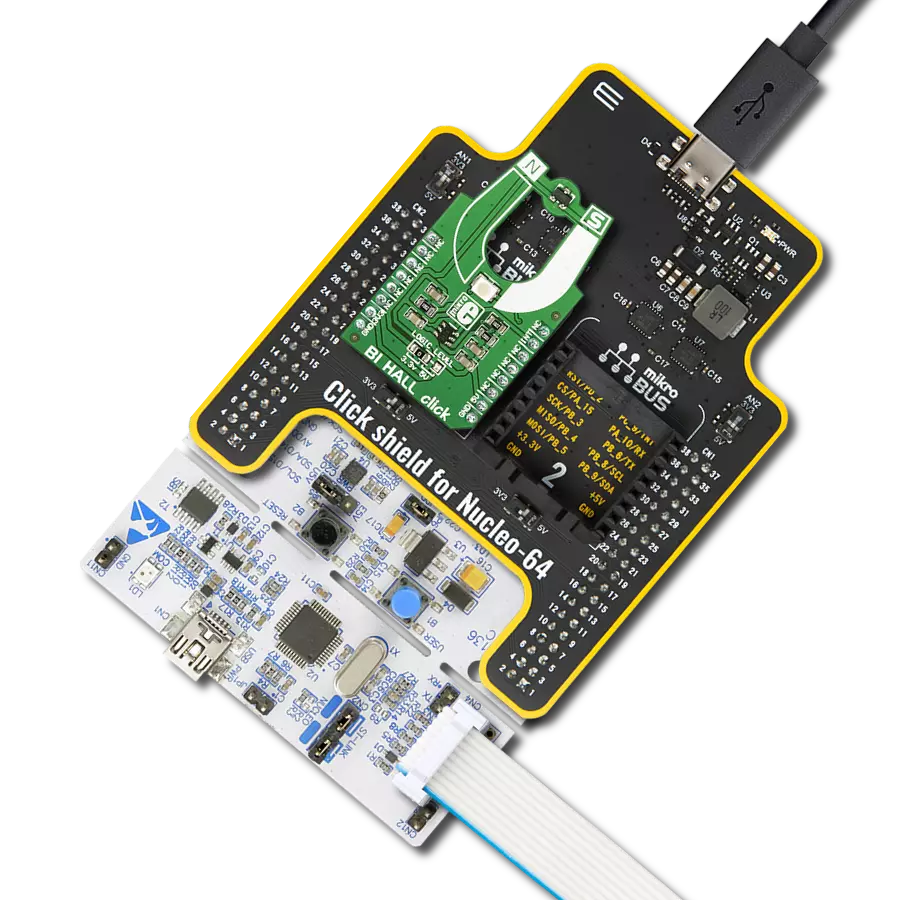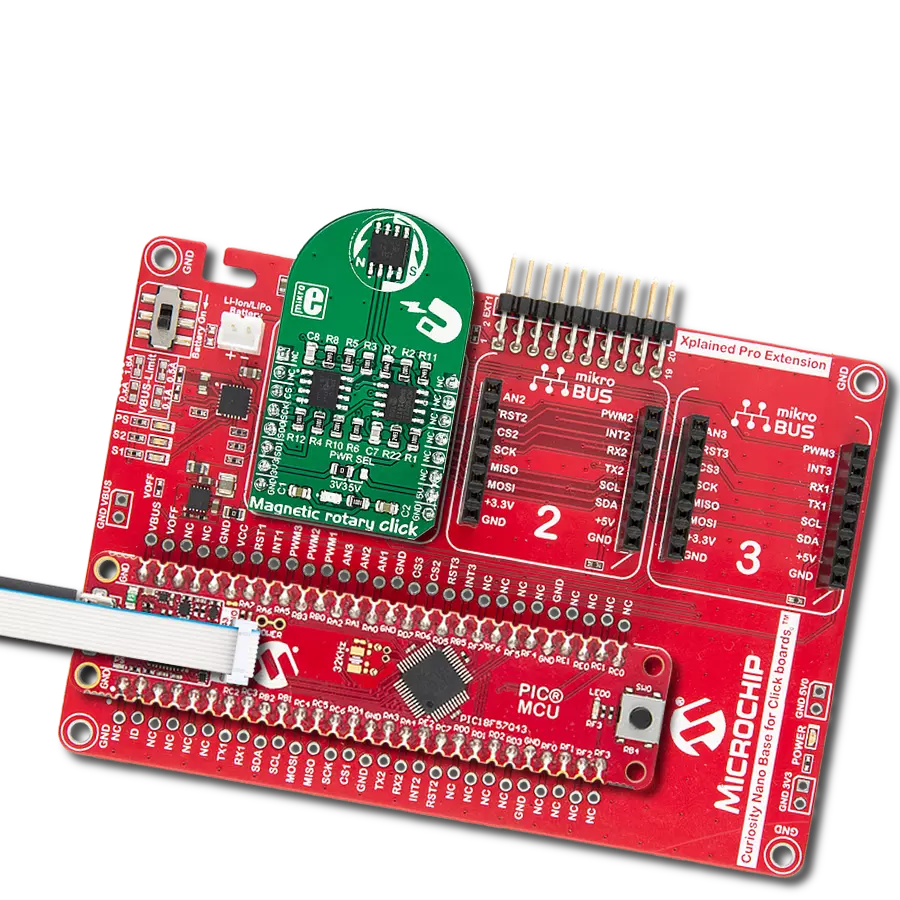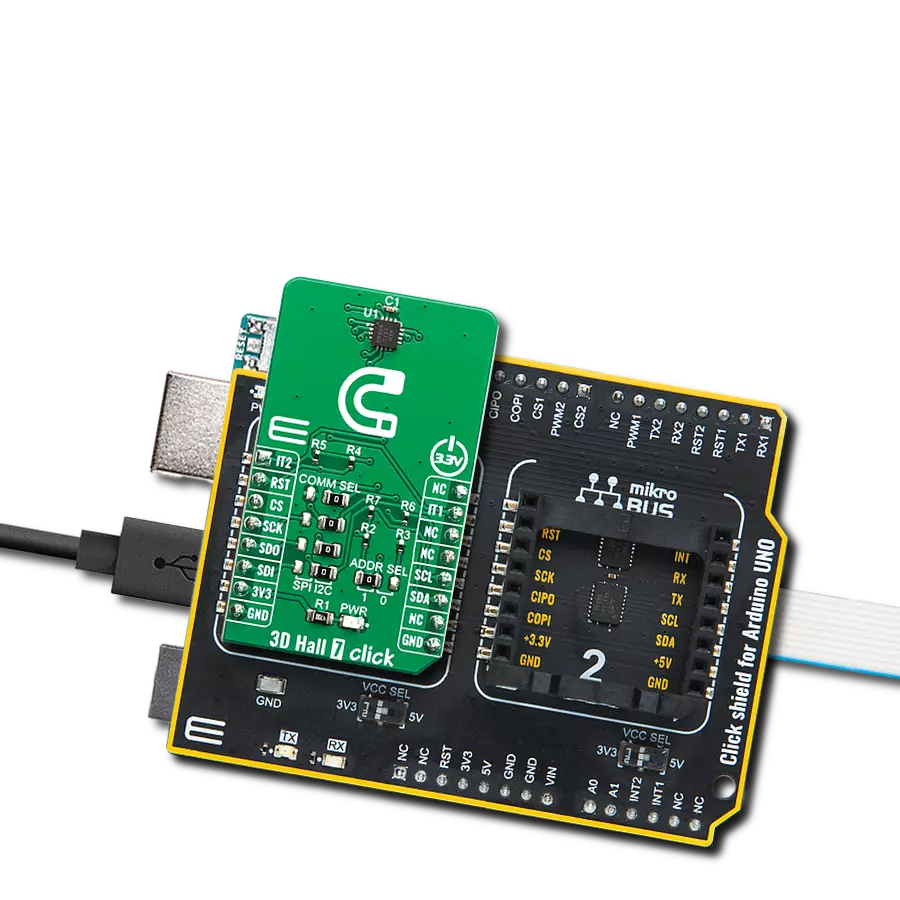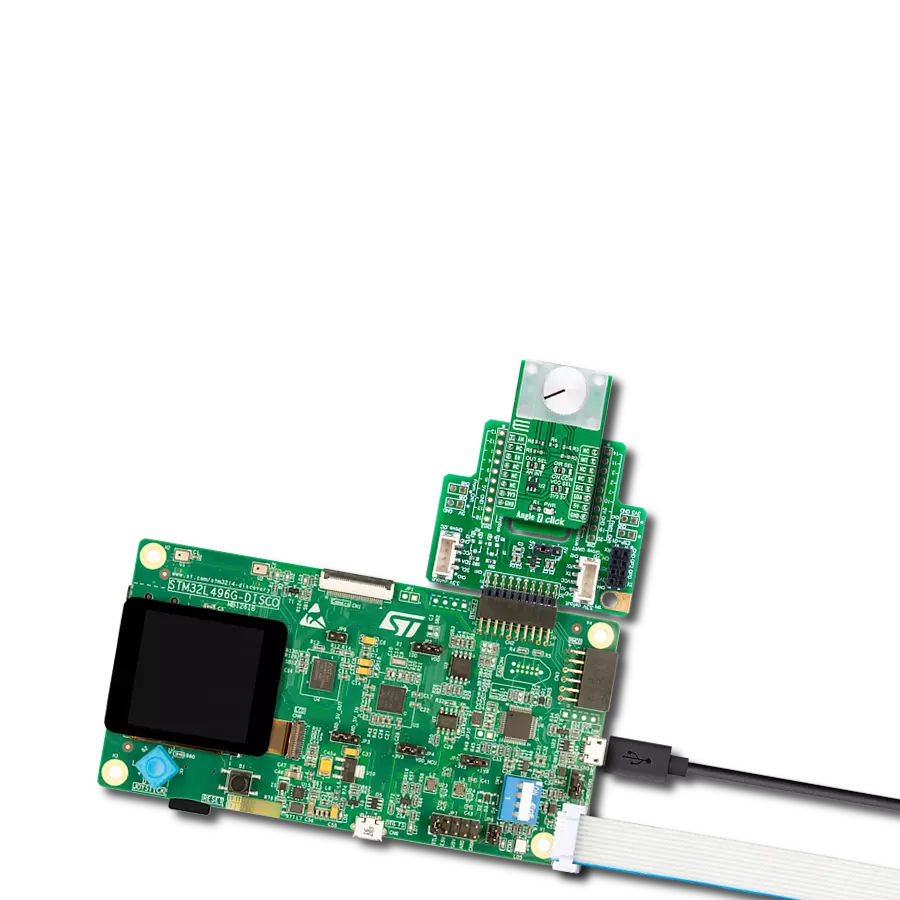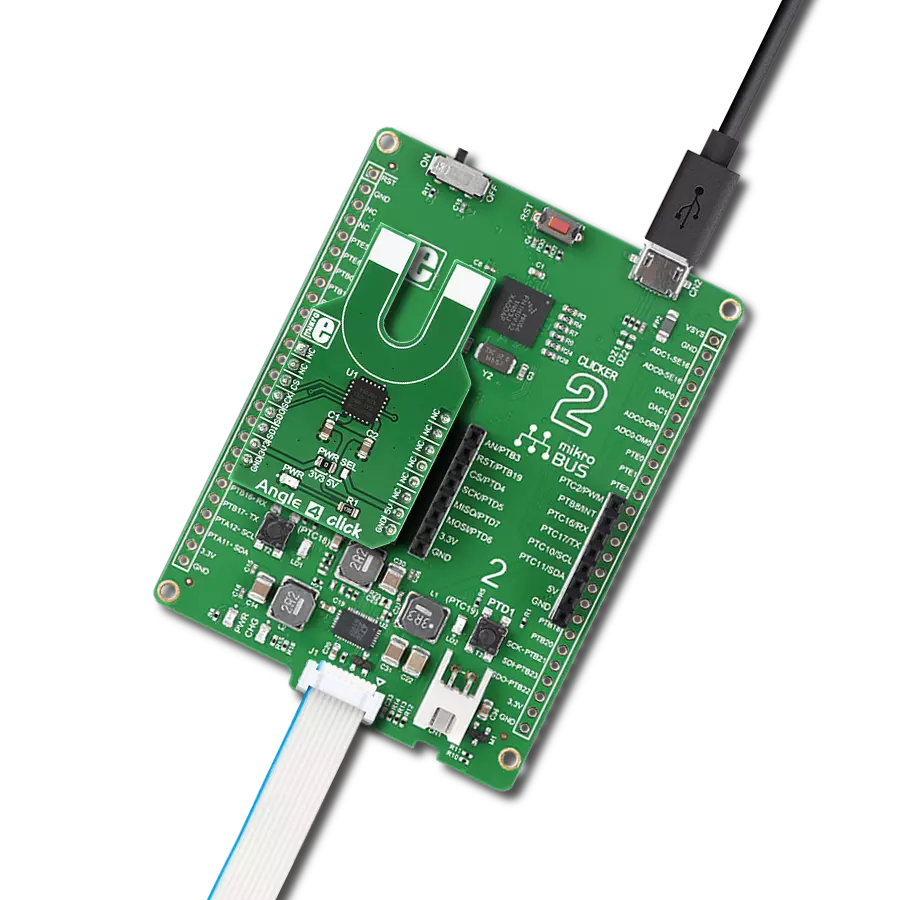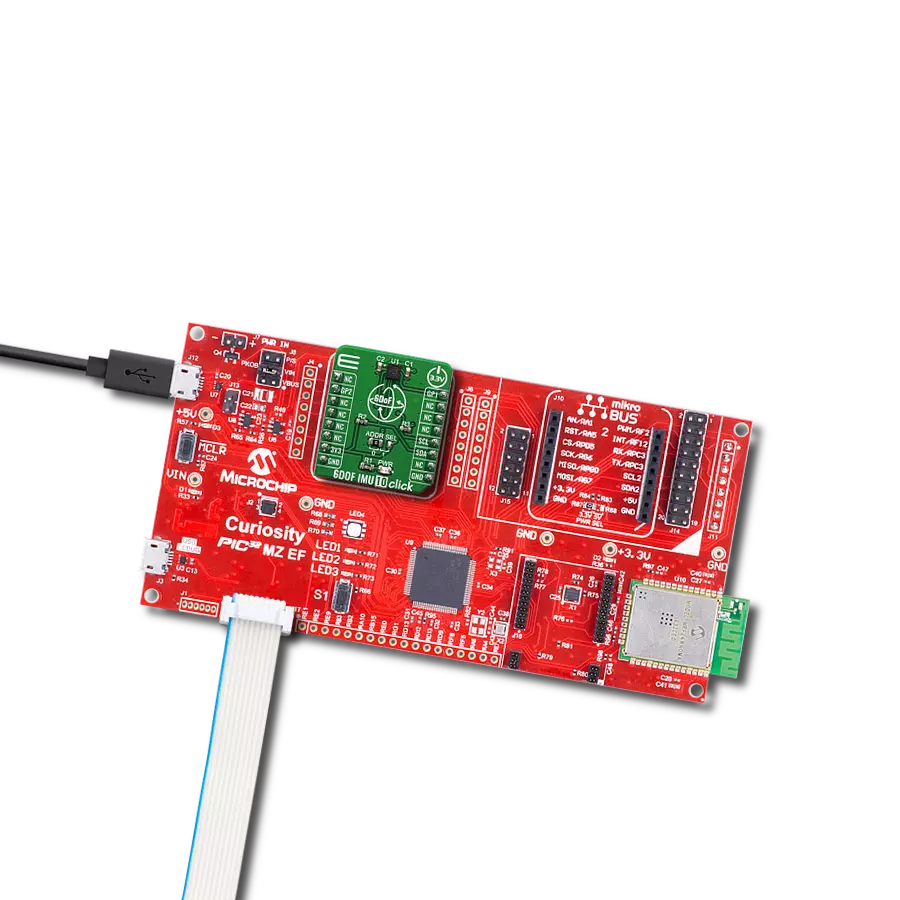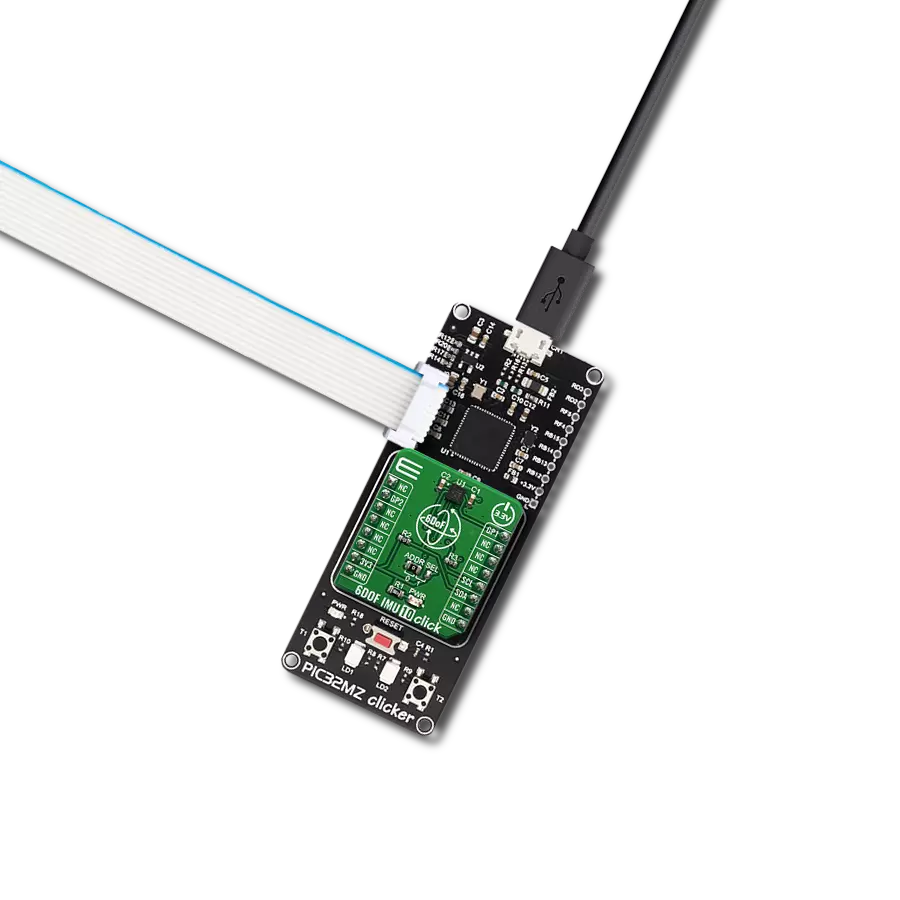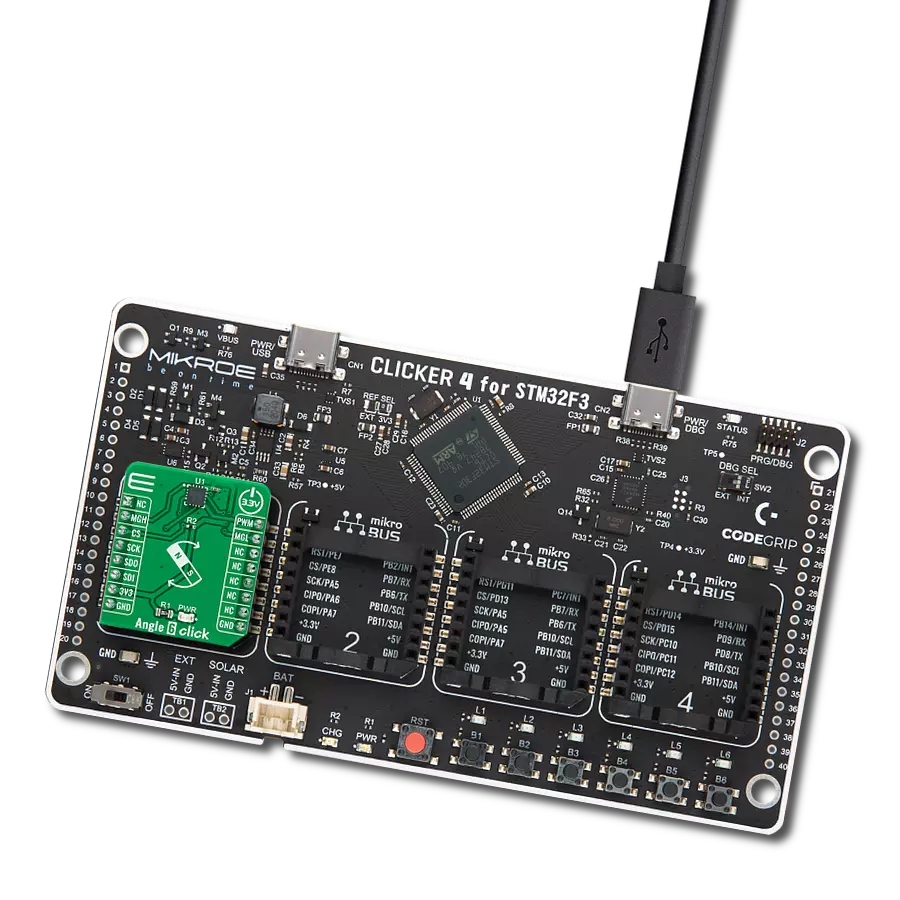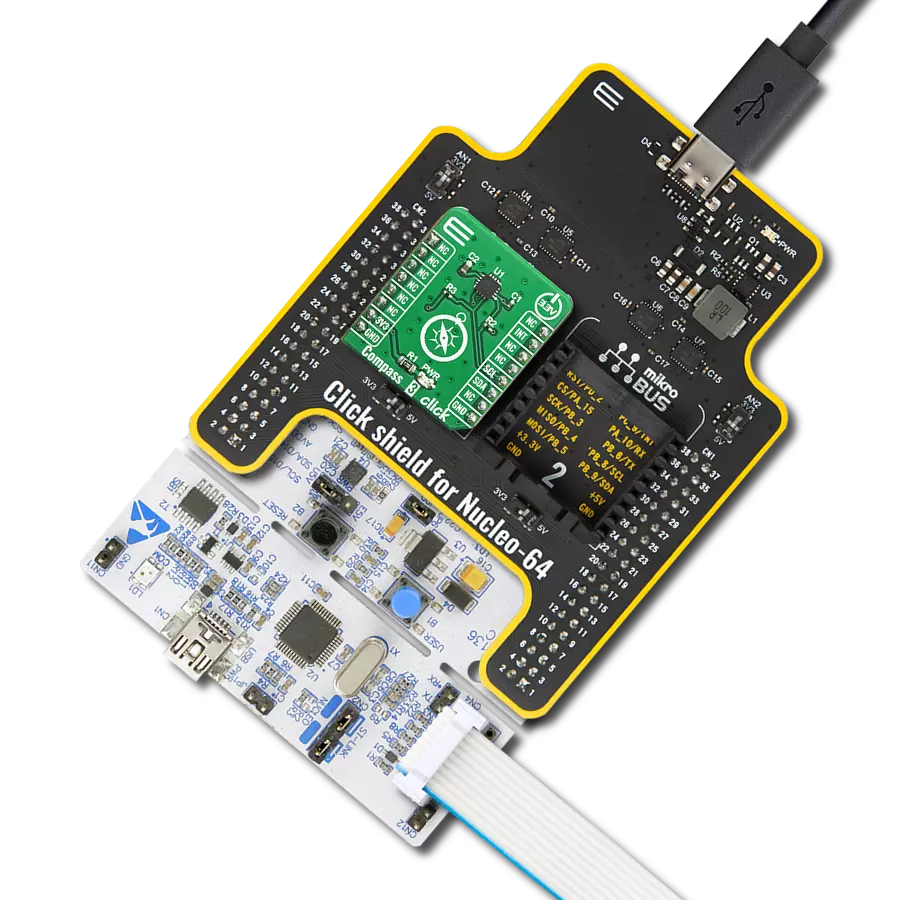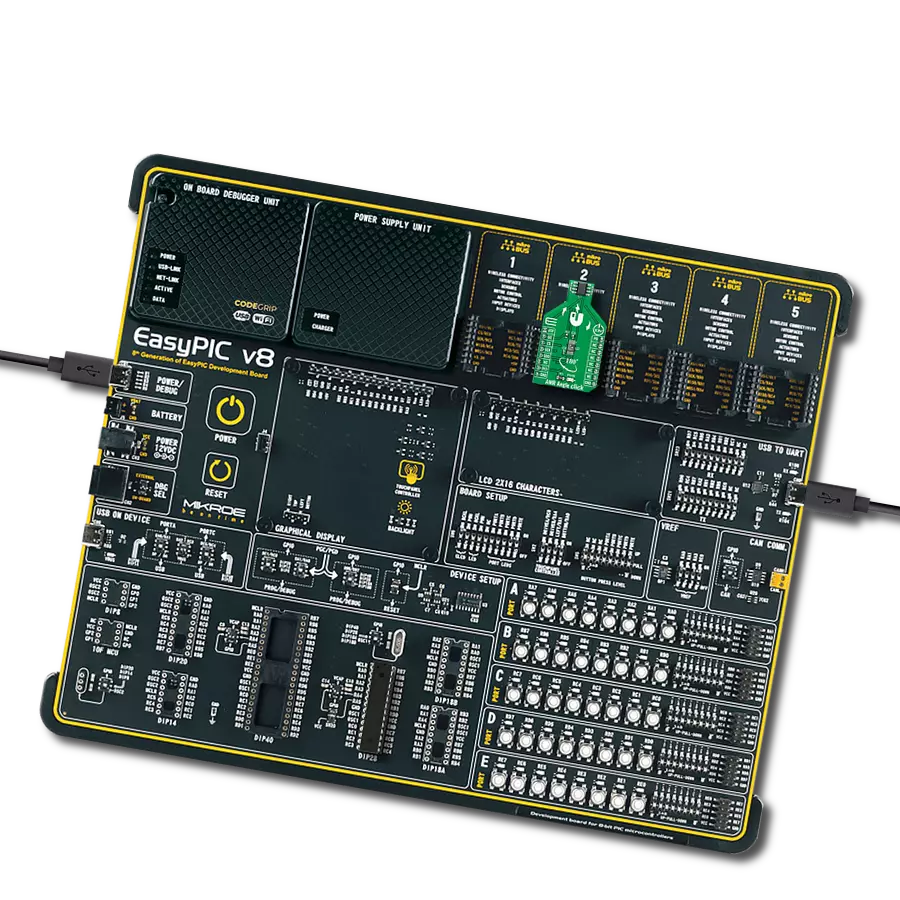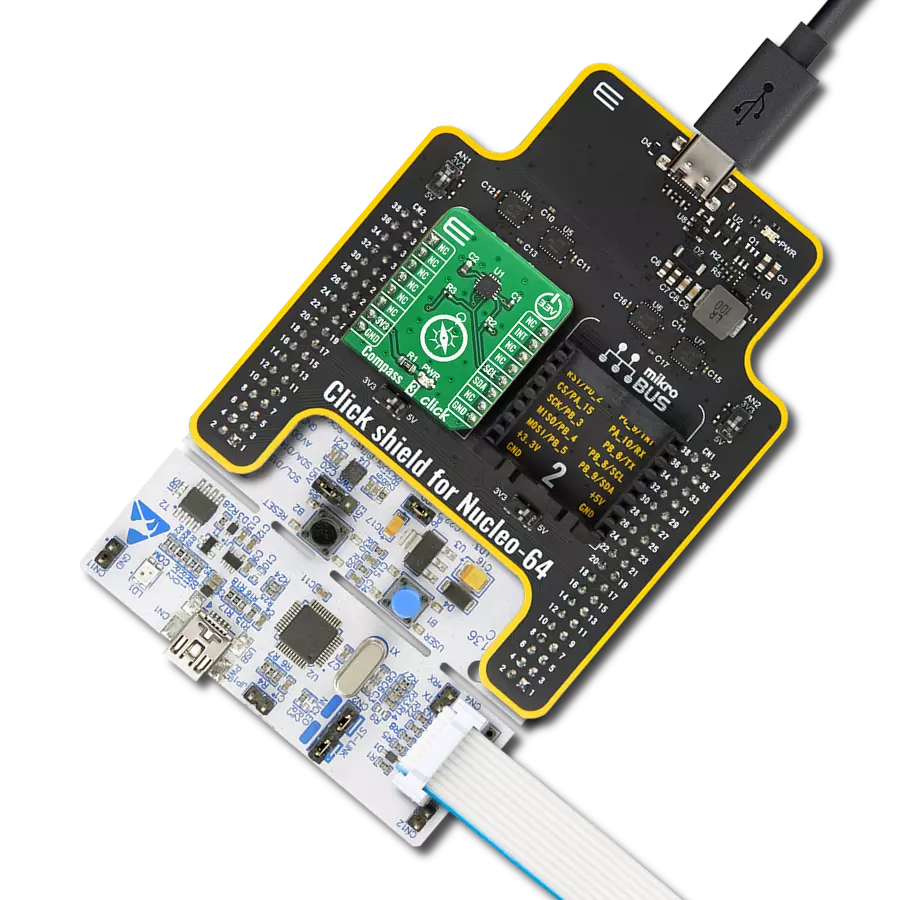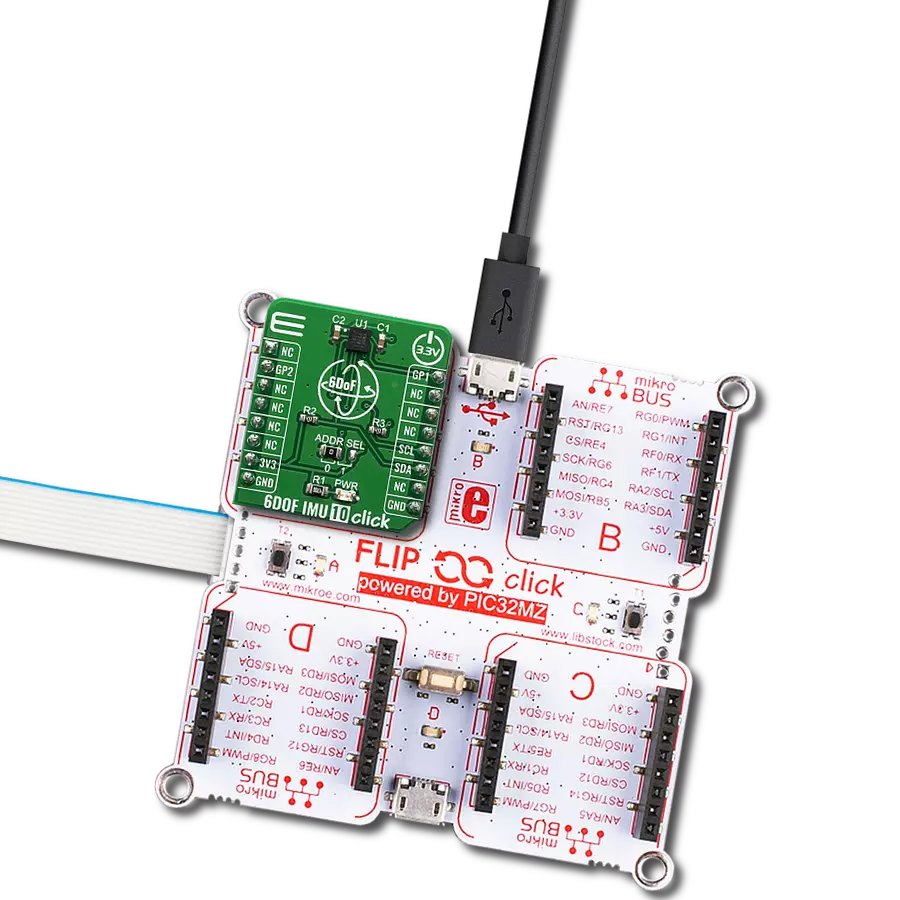Achieve high-precision three-axis magnetic field measurements, allowing for accurate positioning and orientation sensing in various applications
A
A
Hardware Overview
How does it work?
Compass 4 Click is based on the AK09915, a complete 3-axis magnetic sensor with signal processing from AKM. The AK09915 incorporates magnetic sensors for detecting terrestrial magnetism in the X-axis, Y-axis, and Z-axis, a sensor driving circuit, a signal amplifier chain, and an arithmetic circuit for processing the signal from each sensor. The output signal of each axis sensor is multiplexed, pre-amplified, processed, and digitized by a 16-bit A/D converter (ADC). A three-axis magnetometer can be programmed to measure the magnetic component for each axis within the full-scale range of ±4912 μT and sensitivity of 0.15 µT per LSB. The AK09915 has an analog circuit, digital logic, and interface block integrated into a chip. It also supports nine different Operation Modes that can be chosen by setting the appropriate registers. When the Single
Measurement Mode is set, the magnetic sensor measurement starts. After magnetic sensor measurement and signal processing are finished, measured magnetic data is stored in measurement data registers, and then the AK09915 transits to Power-Down Mode automatically. On transition to Power-Down Mode, the Data Ready (DRDY) bit turns to “1”. When any measurement data registers are read, the DRDY bit turns to “0”. It remains “1” on the transition from Power-Down Mode to another Mode. The Ready output pin of the AK09915 labeled as the DRY is routed to the INT pin of the mikroBUS™ socket. Besides the Data Ready pin, this Click board™ also has the Reset pin (RST), routed to the appropriate position on the mikroBUS™. Compass 4 Click allows for both I2C and SPI interfaces with a maximum frequency of 2.5MHz for I2C and 4MHz
for SPI communication. The selection can be performed by positioning SMD jumpers labeled COMM SEL to an appropriate position. Note that all the jumpers must be placed on the same side, or the Click board™ may become unresponsive. While the I2C interface is selected, the AK09915 allows the choice of the last two significant bits (LSB) of its I2C slave address. This can be done by using the SMD jumper labeled as ADDR SEL. Four different addresses can be set depending on the positions of each of the ADDR SEL jumpers. This Click board™ can be operated only with a 3.3V logic voltage level. The board must perform appropriate logic voltage level conversion before using MCUs with different logic levels. Also, it comes equipped with a library containing functions and an example code that can be used as a reference for further development.
Features overview
Development board
Nucleo-64 with STM32F091RC MCU offers a cost-effective and adaptable platform for developers to explore new ideas and prototype their designs. This board harnesses the versatility of the STM32 microcontroller, enabling users to select the optimal balance of performance and power consumption for their projects. It accommodates the STM32 microcontroller in the LQFP64 package and includes essential components such as a user LED, which doubles as an ARDUINO® signal, alongside user and reset push-buttons, and a 32.768kHz crystal oscillator for precise timing operations. Designed with expansion and flexibility in mind, the Nucleo-64 board features an ARDUINO® Uno V3 expansion connector and ST morpho extension pin
headers, granting complete access to the STM32's I/Os for comprehensive project integration. Power supply options are adaptable, supporting ST-LINK USB VBUS or external power sources, ensuring adaptability in various development environments. The board also has an on-board ST-LINK debugger/programmer with USB re-enumeration capability, simplifying the programming and debugging process. Moreover, the board is designed to simplify advanced development with its external SMPS for efficient Vcore logic supply, support for USB Device full speed or USB SNK/UFP full speed, and built-in cryptographic features, enhancing both the power efficiency and security of projects. Additional connectivity is
provided through dedicated connectors for external SMPS experimentation, a USB connector for the ST-LINK, and a MIPI® debug connector, expanding the possibilities for hardware interfacing and experimentation. Developers will find extensive support through comprehensive free software libraries and examples, courtesy of the STM32Cube MCU Package. This, combined with compatibility with a wide array of Integrated Development Environments (IDEs), including IAR Embedded Workbench®, MDK-ARM, and STM32CubeIDE, ensures a smooth and efficient development experience, allowing users to fully leverage the capabilities of the Nucleo-64 board in their projects.
Microcontroller Overview
MCU Card / MCU
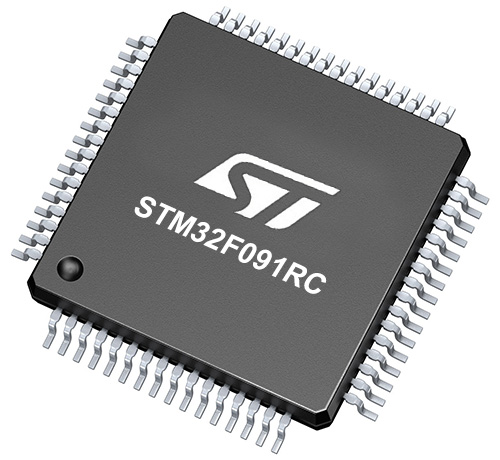
Architecture
ARM Cortex-M0
MCU Memory (KB)
256
Silicon Vendor
STMicroelectronics
Pin count
64
RAM (Bytes)
32768
You complete me!
Accessories
Click Shield for Nucleo-64 comes equipped with two proprietary mikroBUS™ sockets, allowing all the Click board™ devices to be interfaced with the STM32 Nucleo-64 board with no effort. This way, Mikroe allows its users to add any functionality from our ever-growing range of Click boards™, such as WiFi, GSM, GPS, Bluetooth, ZigBee, environmental sensors, LEDs, speech recognition, motor control, movement sensors, and many more. More than 1537 Click boards™, which can be stacked and integrated, are at your disposal. The STM32 Nucleo-64 boards are based on the microcontrollers in 64-pin packages, a 32-bit MCU with an ARM Cortex M4 processor operating at 84MHz, 512Kb Flash, and 96KB SRAM, divided into two regions where the top section represents the ST-Link/V2 debugger and programmer while the bottom section of the board is an actual development board. These boards are controlled and powered conveniently through a USB connection to program and efficiently debug the Nucleo-64 board out of the box, with an additional USB cable connected to the USB mini port on the board. Most of the STM32 microcontroller pins are brought to the IO pins on the left and right edge of the board, which are then connected to two existing mikroBUS™ sockets. This Click Shield also has several switches that perform functions such as selecting the logic levels of analog signals on mikroBUS™ sockets and selecting logic voltage levels of the mikroBUS™ sockets themselves. Besides, the user is offered the possibility of using any Click board™ with the help of existing bidirectional level-shifting voltage translators, regardless of whether the Click board™ operates at a 3.3V or 5V logic voltage level. Once you connect the STM32 Nucleo-64 board with our Click Shield for Nucleo-64, you can access hundreds of Click boards™, working with 3.3V or 5V logic voltage levels.
Used MCU Pins
mikroBUS™ mapper
Take a closer look
Click board™ Schematic

Step by step
Project assembly
Software Support
Library Description
This library contains API for Compass 4 Click driver.
Key functions:
compass4_get_interrupt- Gets INT pin state (DRDY pin)compass4_get_single_axis- Gets single axis valuecompass4_get_magnetic_flux- Gets magnetic flux of X\Y\Z axis value
Open Source
Code example
The complete application code and a ready-to-use project are available through the NECTO Studio Package Manager for direct installation in the NECTO Studio. The application code can also be found on the MIKROE GitHub account.
/*!
* \file
* \brief Compass4 Click example
*
* # Description
* This demo application measures magnetic flux data.
*
* The demo application is composed of two sections :
*
* ## Application Init
* Initializes the driver and resets the module, then checks
* the communication with the module and sets the module default configuration.
*
* ## Application Task
* Reads magnetic flux data and displays the values of X, Y, and Z axis to
* the USB UART each second.
*
* \author MikroE Team
*
*/
// ------------------------------------------------------------------- INCLUDES
#include "board.h"
#include "log.h"
#include "compass4.h"
// ------------------------------------------------------------------ VARIABLES
static compass4_t compass4;
static log_t logger;
// ------------------------------------------------------ APPLICATION FUNCTIONS
void application_init ( void )
{
log_cfg_t log_cfg;
compass4_cfg_t cfg;
uint8_t device;
/**
* Logger initialization.
* Default baud rate: 115200
* Default log level: LOG_LEVEL_DEBUG
* @note If USB_UART_RX and USB_UART_TX
* are defined as HAL_PIN_NC, you will
* need to define them manually for log to work.
* See @b LOG_MAP_USB_UART macro definition for detailed explanation.
*/
LOG_MAP_USB_UART( log_cfg );
log_init( &logger, &log_cfg );
log_info( &logger, "---- Application Init ----" );
// Click initialization.
compass4_cfg_setup( &cfg );
COMPASS4_MAP_MIKROBUS( cfg, MIKROBUS_1 );
compass4_init( &compass4, &cfg );
compass4_hardware_reset( &compass4 );
Delay_ms ( 500 );
device = compass4_check_device( &compass4 );
if ( device == 0 )
{
log_printf( &logger, ">> Device communication [ OK ] \r\n" );
}
else
{
log_printf( &logger, ">> Device communication [ ERROR ] \r\n" );
for ( ; ; );
}
compass4_configuration ( &compass4, COMPASS4_CTRL1_WM_STEPS_5 |
COMPASS4_CTRL1_NOISE_ENABLE,
COMPASS4_CTRL2_MODE_CONT_1 |
COMPASS4_CTRL2_SDR_LOW_NOISE |
COMPASS4_CTRL2_FIFO_ENABLE );
log_printf( &logger, ">> Start measurement \r\n" );
}
void application_task ( void )
{
compass4_flux_t flux;
uint8_t err;
err = compass4_get_magnetic_flux( &compass4, &flux );
if ( err != 0 )
{
log_printf( &logger, ">> Measurement error \r\n" );
}
else
{
log_printf( &logger, ">> Magnetic flux data << \r\n" );
log_printf( &logger, ">> X: %.2f \r\n", flux.x );
log_printf( &logger, ">> Y: %.2f \r\n", flux.y );
log_printf( &logger, ">> Z: %.2f \r\n", flux.z );
}
log_printf( &logger, "-----------------------------\r\n" );
Delay_ms ( 1000 );
}
int main ( void )
{
/* Do not remove this line or clock might not be set correctly. */
#ifdef PREINIT_SUPPORTED
preinit();
#endif
application_init( );
for ( ; ; )
{
application_task( );
}
return 0;
}
// ------------------------------------------------------------------------ END
Additional Support
Resources
Category:Magnetic
